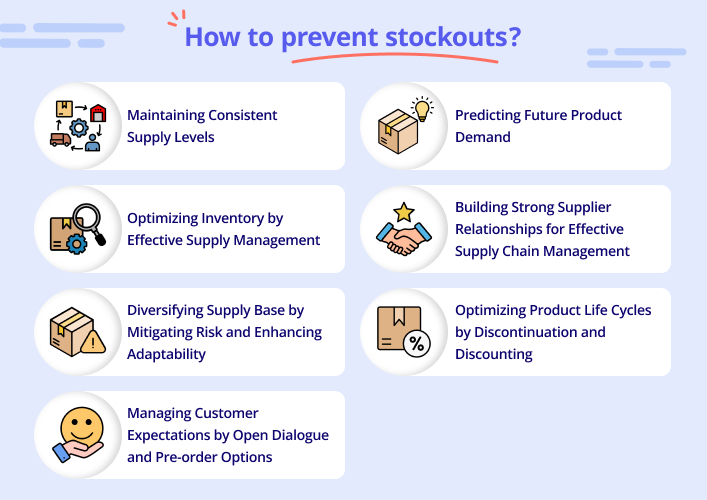What do you mean by going out of stock?
Stockouts, sometimes known as going out of stock, describe when an online shop runs out of a certain item or items. This signifies that the business has sold out of that particular item and is now unable to take any further orders for it. Customers experience frustration and disappointment when they are unable to buy an item they had planned to buy and get right away because it was out of stock.
Furthermore, when a business runs out of a product, it may hurt its image and customer happiness. Therefore, it is critical for online stores to take measures to avoid product shortages and have a steady supply on hand.
Causes of stockouts?
- Stockouts might result from insufficient restocking mechanisms or sloppy record-keeping in the inventory department. Items may seem to be in stock while they are really out of stock if inventory levels aren’t updated in real time or if there are any delays in restocking inventory.
- Stockouts are possible because of fluctuations in demand, particularly during high seasons or as a result of unforeseen circumstances. Stockouts may occur suddenly if the demand for a product is higher than the supply.
- Manufacturing problems or late delivery from suppliers may cause stockouts. If the e-commerce company is dependent on external suppliers, then stockouts and insufficient inventory are possible results of supply chain interruptions.
- Stockouts may also be caused by problems inside the e-commerce system itself, for example when the inventory control software fails or when there are problems syncing the various sales channels. Stockouts may occur if inventory levels aren’t accurately updated or if there are problems with the systems’ ability to communicate with one another.
- Stockouts may result from inefficient product lifecycle management, such as the inability to stop or refill items at the appropriate times. Products that have been discontinued but are still shown as available may cause shortages if buyers try to make orders for them.
How to prevent stockouts?

In order to avoid stockouts in ecommerce, careful inventory management and forward planning are essential. You may take the following measures to reduce the possibility of going out of stock:
- Make sure your supply levels remain constant by using a reliable inventory management system. Maintain accurate inventory records by updating and tracking stock levels on a regular basis.
- Furthermore, predict future product demand by analyzing past sales, current market conditions, and other variables. By studying historical data and developing precise forecasts, businesses may better prepare for future demand.
- Set minimum and maximum levels for each product’s safety stock and reorder points. Having a safety stock on hand might help smooth out fluctuations in demand and supply. By setting reorder points, you may ensure that you always have enough supplies on hand.
- Maintaining solid connections with your suppliers is priority number four. Maintaining open lines of communication and working closely with suppliers can keep you aware of any supply chain problems or delays. Thus, if you know when stock is about to run short, you may take preventative actions like locating new sources or changing production.
- Spread out your supply base since depending on only one might be risky. You should think about expanding your supply base so that you are less vulnerable to interruptions from a single vendor. This allows for more adaptability and lessens the likelihood of stockouts caused by problems with suppliers.
- Manage product life cycles effectively by killing off or heavily discounting goods that are no longer selling. This makes room for and allows more attention to be paid to products that move more quickly, lowering the likelihood of stockouts.
- Offer alternatives or pre-order choices, and specify when you expect the supply to be restocked. Keeping customers’ expectations realistic through open dialogue helps keep them from becoming dissatisfied.
Conclusion
As mentioned in the blog, online retailers that want to avoid stocking out completely should prioritize efficient inventory management. This involves things like keeping tabs on stock, anticipating when more will be needed, establishing reorder and safety stock points, diversifying supply chains, keeping a close eye on everything, streamlining the fulfillment process, managing products effectively throughout their entire life cycles, and keeping in close contact with customers.
FAQs
What is the best way for a retailer to avoid stockouts?
How does stockout affect customer satisfaction?
How to deal with site visitors when a product is out of stock?
What is the root cause of out-of-stock?
How long must you hold a stock before selling?
Ravi Bhojani is the Chief Marketing Officer (CMO) at Alian Software, where he spearheads the company’s marketing strategies and drives its brand presence in the competitive IT services landscape. With over a decade of experience in the technology and marketing sectors, Ravi has consistently demonstrated his ability to blend innovative marketing techniques with deep industry knowledge to deliver outstanding results.